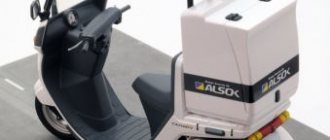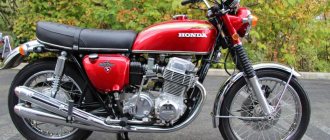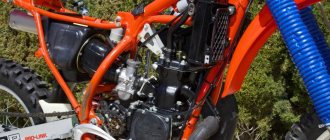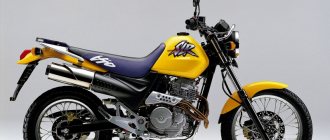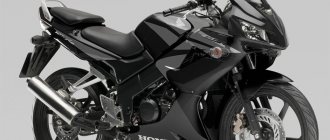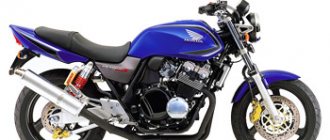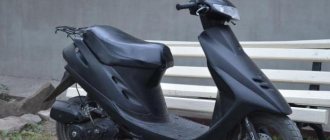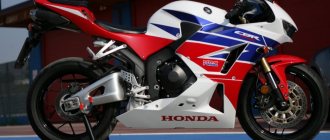The continuation of the Honda Aero model is the Honda CBR400RR version - babyblade, as it was nicknamed after the release of first the 900 cc and then the 600 cc models.
Like those, the “baby” belonged to the sports class.
Compared to other versions, where the exhibition sample appears several years before the start of mass production. The CBR400RR became a record holder. It was first shown on December 15, 1987 , and production began in mid-January of the following year. After spending three years on the assembly line, it received a restyling, and after 9 years , it became history. The model was originally planned for domestic markets, but with the advent of older versions it reached European consumers.
Dimensions and weight
The motorcycle has average dimensions for the class: its wheelbase is 1375 mm, its height is 1080 mm, its length is 1990 mm, its width is 670 mm, and its seat height is 750 mm. The weight of the CBR 400 RR is 170 kg, and its tank volume is 15 liters. Fuel consumption greatly depends on driving style. In an aggressive sports race, up to 10 liters can be spent per hundred kilometers, while during quiet movement, about 5 liters can be spent.
Specifications
The only detail that makes the engine of this motorcycle stand out is the timing gear drive. Otherwise, the motor did not say a new word in development.
The liquid-cooled inline four is completely hidden under a plastic body kit.
This is a regular 4-stroke, 4-cylinder engine with in-line pistons:
- working volume - 399 cm3;
- power - 59 (53) hp;
- number of valves - 16;
- cylinders - 4;
- cooling - liquid;
- fuel supply - carburetor;
- ignition - transistor;
- start - electric starter;
- fuel tank - 15 l.
In 1993, Japanese regulations regarding air emissions became stricter. In order for the bike to meet new standards, the developers strangled the engine, leaving only 53 horses . Accordingly, the maximum torque and speed decreased . But European mechanics know what the changes are and are able to remove the restrictions.
Transmission and clutch
The torque from the six-speed gearbox is transmitted to the rear wheel via a classic chain drive.
The motorcycle was equipped with a 6-speed gearbox . The developers have done their best so that any gear can be engaged easily, allowing the bike to accelerate quite dynamically from the very start.
There is only one complaint about the box. Very frequent switching at the beginning of the range. Many believe that with a speed of under 200 km, 6 gears could be scattered throughout the entire range. The developers commented on this by saying that due to the new standards, the 6th stage would not have found application, going beyond the new running data
- The clutch, traditionally for the concern, is multi-disc , oil bath.
- Main drive - chain.
Brakes
Front brakes.
Rear brakes.
This block came unchanged from the 600 cc Hurricane .
Front: brakes
- number of disks - 2;
- diameter - 296 mm;
- support - 4-piston.
Rear brakes:
- number of disks - 1;
- diameter - 220 mm;
- support - 2-piston.
Since the model was intended only for tracks, no options were planned.
Chassis and brakes
The frame of the bike is diagonal and made of aluminum. The latter circumstance makes the motorcycle lighter and much more in line with the sporty direction of the motorcycle than, for example, a steel one. The wheels are alloy and look very elegant, despite their simplicity.
At the rear, a progressive monoshock absorber is used as suspension. At the front, a 41 mm telescopic fork is used. The rear brake features a 220 mm disc along with a two-piston caliper, while the front uses a pair of 275 mm discs along with four-piston calipers.
Driving performance
The stated maximum speed is 185 km/h . Users have noticed that it is really fashionable to push up to 190 km/h , no more. But if you remove the choke in the carburetor, you can “anneal” it so that the needle will lie motionless. The most modest assumptions voiced the mark at 215–235 km/h .
Acceleration to hundreds
Acceleration from zero to 100 is not impressive.
The minimum that was achieved in field tests was 4.5 seconds to 100 km/h .
Fuel consumption
The developers promised fuel consumption of 3 liters per 100 km. According to users, less than 5 is impossible. Moreover, the indicator does not depend on the quality of the road.
Flaws
It is inconvenient to change spark plugs and clean carburetors on a bike - you have to remove a lot of things.
During operation, users found only 2 minuses. Moreover, both are explained by the sporting fate of the model.
- Good traction only at high speeds - the engine is boosted for racing.
- A small resource of parts - when the bike is constantly in the hands of specialists, the resource is not the main thing.
The second is the lack of original spare parts , since no official support for the model was offered in Europe.
and dignity
Overall, the Honda CBR400RR is one of the best sporty city bikes - nimble, light and economical.
The model has many more advantages:
- good wind protection, unusual for sportsmen;
- excellent brakes;
- excellent dynamics for its class;
- despite the huge amount of body kit - light weight;
- reasonable price for used.
Brief history of the model
- 1983 - start of production and sales.
Model
: Honda CBR400F (Japan).
- 1984 - the appearance of the Endurance modification and the limited edition Endurance F-3.
Model
: Honda CBR400F; Honda CBR400F Endurance; Honda CBR400F Endurance F-3 (Japan).
- 1985 is the last year of production. The appearance of a limited edition Formula-3.
Model
: Honda CBR400F Endurance; Honda CBR400F Formula-3 (Japan).
Motorcycle history
The bike was originally called the Honda CBR 400 Aero. But since 1988, its appearance was significantly changed, and at the same time its name was changed to Hurricane. In 1994, the motorcycle was modernized and received a new name Fireblade. The device was created in the style of the more expensive Honda CBR 900 RR Fireblade motorcycle (years of production: 1992-1995).
The Honda CBR 400 was equipped with a rather complex 4-cylinder engine with a displacement of 399 cc. The engine characteristics were advanced for that time: max. power 59 l. s., max. torque – 39 Nm. However, during modernization in 1993, due to the need to meet new environmental requirements, the power was reduced to 53 hp. With. The engine showed its main output in the upper speed range from 10,000 to 12,500 rpm.
To distinguish motorcycles of the first generation (1988-1989) from the second (1990-1993), you need to look at the frame number. The first generation had the index NC23 as its number, the second – NC29.
These generations were distinguished solely by their appearance: the shape of the frame, the saddle, and the plastic body kit. From a technical point of view, the device has not changed at all. The third generation of motorcycles (1993-1999) differed from the second by a lower-power power unit.
Among the exceptional features of the Honda CBR400RR motorcycle, the most notable are the aluminum frame, gear-driven timing mechanism, conventional telescopic forks at the front and a monoshock absorber at the rear. Transmission – manual, 6-speed.
Honda CBR 400F3
Maintenance of the Honda SBR 400 motorcycle
Compared to many other 4-cylinder motorcycles, caring for and maintaining the Honda CBR 400RR engine is not a hassle. The power unit has a long service life, but is quite demanding in terms of timely replacement of consumables and oil.
Despite the fact that the power system consists of four carburetors, they are easier to regulate than on similar Yamaha or Suzuki engines. In addition, original Keihin carburetors are renowned for their reliability, trouble-free operation and ease of maintenance.
Honda is distinguished by its motorcycle gearboxes. Thanks to their exceptional reliability and quality, they have become the benchmark in the world of motorcycles. The clutch life is 50 thousand with an aggressive driving style, and much more with a calm driving style.
The suspension and chassis are quite reliable and show good performance even by modern standards. The braking system does not cause any complaints, although many complain about its lack of information. This drawback can be easily corrected by installing reinforced brake hoses.
Honda CBR 400
Post Views: 12,766
Recommendations
- Anderson, Steve (February 1987), "High Tech 400; Japan's 400 class opens a window into our motorcycle future [inset] Honda CBR400R; Father of the Hurricane,” Bicycle World
, vol. 26 no. 2. pp. 34–41. - Cook, Mark; Gillies, Mike; Gingerelli, Dane; Smith, Jerry; Wolf, Bill (February 1987), "Japan's Best Kept Secrets", The Cycle Guide
, vol. 21 no. 2. P. 20–.
- Lindemann, Mark (May 1985), "Honda CBR400F: A 13,000 RPM Wristwatch", Cycle
, vol. 36 no. 5, page 26
Honda CBR 400 (CBR400RR) motorcycle review
The device itself is made quite compactly and compactly, it is felt that there was a calculation for the short Japanese. With a height of 183 cm, I did not sit very comfortably by sportbike standards. The legs were bent too much at the knees, I wanted a higher and longer saddle, otherwise I couldn’t move or move away, and I had to reach for the steering wheel. For comparison, I felt much more comfortable on the CBR900RR or CBR600F2 of the same years. The passenger, let’s say, more or less, again by the standards of sportbikes. The convenience of traveling together depends greatly on the size of the pilot and passenger.
In terms of controllability, the motorcycle is, of course, excellent. It steers, which is called the power of thought, especially on stock tires (110 front and 150 rear). From knee to knee on cartodromic ligaments it is easy and not forced. I would call it “The best karting sport bike.” The motorcycle forgives a lot of pilot mistakes, a small skid of the front wheel, a small skid of the rear wheel, braking while tilted... a lot of things.
It's not bad for the city either. The device is of moderate width + quite light. The visibility of the shoulders and elbows in the rear-view mirrors is good, but the road is only partially visible)))) You will almost always be the first to leave a traffic light)))) And the fuel consumption is very pleasing: mine was always within 5 liters per hundred IN ANY MODE GO!!!! I don’t know how or why, but that’s how it is.
The Honda engine turned out to be extremely durable, even after going to the collective farm (where it was simply raped), it did not smoke and did not eat oil!!! Unlike the FZR and GSX-R, the CBR engine has more even traction throughout the entire rev range!!! Decent torque even up to 6000 rpm! When competitors have almost no torque up to 6000 rpm!!! Although this coin also has a downside - when starting sharply on a wet surface or hitting road markings, the wheel instantly slips!!! If you switch correctly at the peak of torque, the dynamics are not much worse than those of 600!!! (but of course it’s still not the same)! With a passenger, it’s hard for the engine, it’s not interesting, but its elasticity allows you to move comfortably!!! The general impression of the engine is that it is reliable, not loud (not annoying), elastic, torquey, and quite adequate for the city!!!
I have not had any problems with this device in 2 years of its use. Initially, if the equipment came to you without any problems, then it needs to be maintained in condition and that’s it. change consumables!
I didn’t observe any major breakdowns... the only thing I didn’t ask (the owners of these Siberians), everyone confirms that the fork breaks... that is, when it hits a bump, there’s a good return!
The motor is good, but you have to order spare parts in advance... if a small sprocket can still fit from the SV400, then the rear one is only original (I’m talking about stock, not tuning). The pads also fit from other motorcycles, you need to look in the catalog. But since the model of this motorcycle was initially designed for the Japanese market, it was accordingly strained with spare parts, unlike the 600rr, which is designed for the European market.. here..
The CBR is an excellent device, both the first and the second model. Acceleration dynamics are excellent, the needle goes far beyond 180 km, it doesn’t eat much, at least mine ate surprisingly very little. It fits perfectly on the rear wheel, excellent control, holds the road perfectly, turns with a bang, but it’s not suitable for Dalnyak, the suspension is very stiff, it’s not comfortable to drive for a long time, and you get tired quickly.
I advise you to take it to anyone who likes a fast, confident ride.
For whom is it intended?
Even if you don’t take into account the official sales markets, the low-set saddle means that motorcyclists of average and below average height will be comfortable on the bike.
The forward-leaning, arm-loaded seat gives you complete control of the motorcycle.
If we remember that all 400s, and this is no exception, are positioned by the Japanese for domestic markets, no other questions arise.
